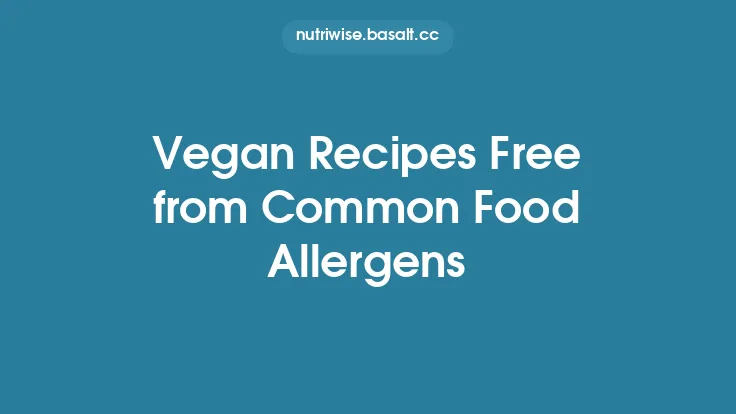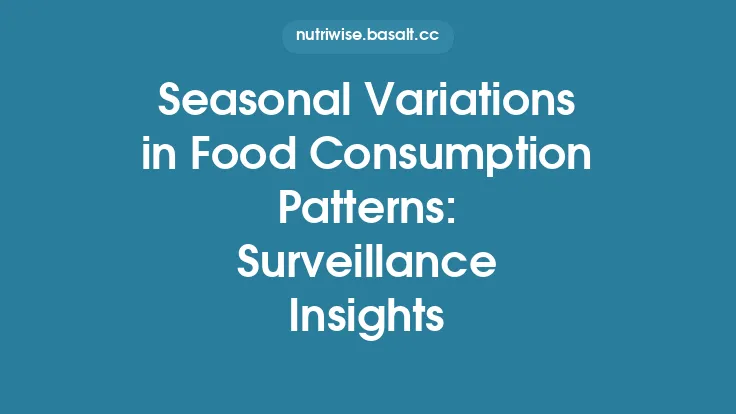The holiday season brings families and friends together around tables laden with dishes that have been passed down through generations. While these foods carry deep cultural meaning and evoke cherished memories, they can also pose hidden dangers for individuals with food allergies. Understanding how allergens intersect with festive customs is essential for creating inclusive celebrations where everyone can partake safely. This article explores the most common allergens found in holiday fare, the ways cultural traditions influence allergen exposure, and practical strategies for hosts, chefs, and guests to manage risk without compromising the spirit of the season.
Common Food Allergens in Holiday Celebrations
Across most regions, the “big eight” allergens—milk, eggs, peanuts, tree nuts, soy, wheat, fish, and shellfish—account for the majority of allergic reactions during festive gatherings. In addition, sesame, mustard, and certain legumes (e.g., lupin) have risen in prevalence and are now recognized as major allergens in many countries.
| Allergen | Typical Festive Sources | Typical Reaction Timeline |
|---|---|---|
| Milk | Butter, cream, cheese, custards, sauces | 5 min – 2 h |
| Eggs | Baked goods, mayonnaise, hollandaise, egg‑based desserts | 5 min – 2 h |
| Peanuts | Peanut butter, candy, sauces, garnish | 5 min – 2 h |
| Tree nuts (e.g., almonds, walnuts) | Marzipan, nut‑based fillings, pralines | 5 min – 2 h |
| Soy | Soy sauce, tofu, soy‑based marinades | 5 min – 2 h |
| Wheat (gluten) | Bread, pastries, dumplings, thickening agents | 5 min – 2 h |
| Fish | Smoked fish, fish‑based spreads, gravies | 5 min – 2 h |
| Shellfish | Shrimp cocktail, crab cakes, lobster bisque | 5 min – 2 h |
| Sesame | Tahini, sesame oil, seed‑crusted breads | 5 min – 2 h |
| Mustard | Mustard sauces, dressings, spice rubs | 5 min – 2 h |
| Lupin | Lupin flour in gluten‑free pastries | 5 min – 2 h |
Reactions can range from mild oral allergy syndrome to severe anaphylaxis, a rapid, potentially life‑threatening systemic response. Because the timing of symptom onset can be unpredictable, early recognition and prompt treatment are critical.
Cultural Variations in Festive Foods and Allergen Risks
Festive menus differ dramatically from one culture to another, and each tradition carries its own set of allergen considerations.
- Western Christmas: Roast turkey or ham often accompanied by gravy thickened with wheat flour; side dishes may include cranberry sauce sweetened with honey (potential pollen cross‑reactivity for some). Desserts such as fruitcake, mince pies, and gingerbread frequently contain nuts, eggs, and dairy.
- Hanukkah: Latkes (potato pancakes) are fried in oil and may be served with sour cream or applesauce; sufganiyot (jelly‑filled doughnuts) are wheat‑based and contain eggs.
- Diwali: Sweets like laddus and barfi are made with ghee (clarified butter), milk solids, and nuts; many are deep‑fried in oil that may have been used for peanuts or sesame.
- Chinese New Year: Dumplings, spring rolls, and sticky rice cakes often contain soy sauce, wheat wrappers, and sometimes shrimp or other shellfish.
- Ramadan/Iftar: Dates, nuts, and pastries such as baklava (phyllo dough, nuts, honey) are common; many dishes incorporate sesame oil or tahini.
- Kwanzaa: Traditional dishes may include collard greens cooked with smoked turkey (potential cross‑contact with peanuts if prepared in a shared kitchen) and sweet potato pies containing dairy and eggs.
Understanding these cultural patterns helps hosts anticipate which allergens are likely to appear and plan accordingly.
Identifying Hidden Allergens in Traditional Dishes
Allergens are not always listed as obvious ingredients. Hidden sources include:
- Flavor enhancers: Hydrolyzed vegetable protein, soy lecithin, and monosodium glutamate (MSG) can introduce soy.
- Thickening agents: Wheat starch, cornstarch, and modified food starch may contain gluten or soy residues.
- Emulsifiers: Polysorbate 80 and mono‑ and diglycerides are often derived from soy.
- Preservatives: Certain sulfites used in dried fruits or wine can trigger reactions in sulfite‑sensitive individuals.
- Cross‑contaminated spices: Ground nutmeg, cinnamon, or spice blends processed in facilities that also handle nuts or sesame.
A systematic ingredient audit—checking both the primary recipe and any pre‑made components (e.g., store‑bought sauces, canned goods)—is essential for accurate allergen identification.
Preventing Cross‑Contact During Preparation and Service
Cross‑contact occurs when an allergen unintentionally transfers to a safe food, typically via shared equipment, surfaces, or hands. The following protocols reduce this risk:
- Dedicated Workstations
- Assign separate cutting boards, knives, and mixing bowls for allergen‑free preparations.
- Color‑code equipment (e.g., red for nuts, blue for dairy‑free) and keep a visual guide in the kitchen.
- Sequential Cooking
- Prepare allergen‑free dishes first, then clean all surfaces thoroughly before moving on to allergen‑containing recipes.
- Use disposable gloves and change them between tasks; wash hands with soap and hot water for at least 20 seconds.
- Utensil Management
- Store utensils in labeled containers to avoid accidental reuse.
- For large gatherings, consider using single‑use disposable serving tools for high‑risk items.
- Storage Separation
- Keep allergen‑free foods on the top shelf of the refrigerator or in sealed containers to prevent drips.
- Label containers with both the dish name and “Allergen‑Free” to alert staff and guests.
- Cooking Vessels
- When possible, use separate pots, pans, and baking trays.
- If sharing is unavoidable (e.g., a single large pot for stew), ensure the allergen is a primary ingredient and clearly communicated; otherwise, prepare a parallel allergen‑free batch.
Labeling and Communication Best Practices
Clear, accurate labeling is the cornerstone of allergen safety.
- Ingredient Lists: Provide a printed or digital list for each dish, highlighting allergens in bold or a contrasting color.
- Allergen Icons: Use universally recognized symbols (e.g., a peanut icon for peanuts, a milk bottle for dairy) alongside dish names.
- Allergen‑Free Markers: Clearly label dishes that are free from the major allergens, but also note any “may contain” warnings for shared equipment.
- Verbal Communication: Encourage guests to ask about ingredients; staff should be trained to answer confidently and direct guests to the written information.
- Digital Platforms: For larger events, a QR code linking to a detailed menu with allergen information can reduce paper waste and allow real‑time updates.
Accommodating Guests with Food Allergies
Inclusivity goes beyond avoiding allergens; it involves thoughtful menu planning and hospitality.
- Alternative Recipes: Offer parallel versions of popular dishes—e.g., a dairy‑free mashed potato made with olive oil or coconut milk, a nut‑free fruitcake using seeds or oat flour.
- Separate Serving Areas: Designate a “safe zone” where allergen‑free foods are displayed on dedicated platters, minimizing the chance of accidental mixing.
- Pre‑Event Coordination: Collect allergy information during RSVP and confirm with guests a few days before the event. This allows time to source specialty ingredients or arrange for commercial allergen‑free products.
- Portion Control for Safety: Serve allergen‑free dishes in individual portions (e.g., pre‑packaged salads, single‑serve desserts) to reduce handling and cross‑contact.
- Respectful Dialogue: Train hosts and servers to respond without judgment; avoid pressuring guests to “just try a bite” and always respect a guest’s decision to abstain.
Emergency Preparedness and Response
Even with meticulous planning, accidental exposure can occur. Being prepared can save lives.
- Epinephrine Availability
- Keep at least two auto‑injectors (e.g., EpiPen) on hand, stored at room temperature and out of direct sunlight.
- Assign a responsible adult to know the location and how to administer them.
- Medical Information Sheet
- Have a printed sheet with each allergic guest’s name, specific allergens, and emergency contact numbers.
- Include instructions for calling emergency services (e.g., “Dial 911”) and any known medical conditions (e.g., asthma).
- Training
- Conduct a brief “allergy emergency drill” with household members or staff before the event.
- Review the steps: recognize symptoms, administer epinephrine, call emergency services, and monitor the individual until help arrives.
- Post‑Reaction Protocol
- After epinephrine administration, keep the person lying down with legs elevated if possible, and monitor vital signs.
- Do not give food or drink unless instructed by medical personnel.
Legal and Ethical Responsibilities for Hosts
In many jurisdictions, hosts of public or commercial events have a legal duty to provide accurate allergen information. While private family gatherings may not be subject to the same regulations, ethical considerations remain:
- Disclosure: Failure to disclose known allergens can be deemed negligent if it leads to injury.
- Reasonable Accommodations: Providing allergen‑free options when feasible aligns with best practice standards and can mitigate liability.
- Documentation: Keeping records of ingredient sources, preparation methods, and communication with guests demonstrates due diligence.
- Insurance: Review homeowner or event insurance policies to understand coverage for allergic reactions.
Resources and Ongoing Education
Staying current with allergen research and guidelines ensures that hosts can adapt to emerging risks.
- Allergy Organizations: The Food Allergy Research & Education (FARE) and the American Academy of Allergy, Asthma & Immunology (AAAAI) publish annual updates on allergen prevalence and management.
- Government Databases: The U.S. Food and Drug Administration (FDA) maintains the “Food Allergen Labeling and Consumer Protection Act” (FALCPA) database, which lists approved allergen statements.
- Culinary Schools: Many culinary programs now include modules on allergen safety; consider short courses or webinars for interested hosts.
- Mobile Apps: Apps such as “AllergyEats” and “ContentChecked” allow users to scan product barcodes for allergen information, useful for last‑minute ingredient checks.
- Community Support: Local allergy support groups often host potluck events with strict allergen protocols, providing practical examples and networking opportunities.
By integrating these resources into holiday planning, hosts can continuously improve safety measures and foster a culture of inclusivity that honors both tradition and health.
Understanding food allergens in festive settings is not merely a checklist; it is a commitment to safeguarding the well‑being of every guest while preserving the joy and cultural richness of holiday celebrations. With informed preparation, clear communication, and proactive emergency planning, families and communities can create memorable feasts where everyone feels welcome at the table.





